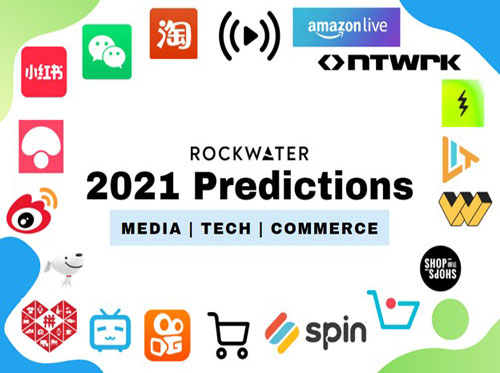Whatnot Raises $50M and the Future of Livestream Commerce
Today marks our 6th episode of the RockWater Roundup.
What’s In This Episode
Whatnot, a livestream commerce marketplace for authenticated resale (like trading cards), just raised a $50 million Series B. We explain the origins of China’s $170+ billion livestream selling market, the rapid growth of the $15 billion sports memorabilia / collectibles market, and whether the future US winners will be the large tech incumbents or upstarts like NTWRK, Newness, and Whatnot, who focus on niche vertical communities.
Subscribe to our newsletter. We explore the intersection of media, technology, and commerce: sign-up link
Learn more about our market research and executive advisory: RockWater website
Email us: rounduppod@wearerockwater.com
You can listen, subscribe, and follow our show on:
Our ask: wherever you listen, and particularly on Apple Podcasts, please give us a rating and write a short review. And forward this email to a friend. Doing so will help others discover the RockWater Roundup.
Episode Transcript
The conversation was lightly edited for clarity.
Chris Erwin:
So Andrew, did you see the recent $50 million capital raise for Whatnot?
Andrew Cohen:
Yeah, no. It feels like post-COVID 2020 to 2021. We’ve been hearing a ton about the explosion of livestream shopping and a ton about the explosion of the collectibles market. So makes sense that these worlds will be colliding sooner or later.
Chris Erwin:
Hundred percent. Whatnot is a livestream commerce platform, and they are particularly looking to grow in sports cars and memorabilia. Little bit more detail on the company, they just raised $20 million in March of this year, building off of another $4 million raise in December. And so the recent round was led by the Y Combinator Continuity fund and then Andreessen led the prior round in March. So a little bit of backstory here is that Whatnot was originally just going to be a GOAT or StockX tight marketplace with static images for authenticated resale but they then saw growth in livestream sales, so significant that the CEO said, “We’re now 95% focused on a livestream commerce company.” And they also saw the explosion, particularly in trading cards as past January. We’ll get to that.
Chris Erwin:
So just thinking about how they’re going to use their funds, we know from the Series A announcement that they wanted to expand into over a hundred different verticals based on what the CEO said, “Outside of their core Pokemon and sports trading cards and going into natural extensions like comic books, vintage hardware, video games, and more.” Likely to Series B is focused on continued category expansion and hiring and rapid user growth. Now, like the context here, like you said, that we’ve seen a lot of seed and Series A raises in the first half of this year for livestream commerce. And just have to note like literally just this morning, it was announced that Depop, which is a Gen Z fashion resale marketplace just sold the Etsy for 1.6 billion. So when you’re talking about like used and resold goods, definitely very relevant data point. But I think it’s time to take a step back and talk about what overall is livestream commerce and what activity are we seeing?
Andrew Cohen:
Very good question. So livestream shopping if you’re unfamiliar, very much like what it sounds like, it’s essentially QVC meets Twitch. Bloomberg described it, I like this as, “Part variety show, part infomercial, part group chat.” And the reason we’ve been hearing about it so much this year is because it is absolutely blowing up in China. So in 2020 alone, there were over 500 million livestream shoppers in China spending over 170 billion on livestream shopping platforms, which is up nearly 500% since 2018. And over the next three years, we’re excited to see another 500 billion transactions happening on livestream shopping platforms in China. So these livestream shopping events are led by what’s called KOLs or key opinion leaders, which is essentially the Chinese version of an influencer. Unlike even our biggest influencers here, they really hold outsize power, influence, and reach. Think Kylie Jenner meets Taylor Swift meets LeBron James.
Andrew Cohen:
So for example, Viya who is probably the top livestream commerce influencer in China on Alibaba Singles’ Day, which is basically their version of Prime Day, had a livestream shopping event that reached 37 million live viewers in a single stream, which is larger than the audience for the finale of Game of Thrones or for Sunday Night Football. And that stream generated over $425 million in sales in just a few hours. So it’s crazy. We saw these numbers and we were thinking to ourselves, we had the double check and it was unbelievable. We’re thinking, “How come people aren’t doing this in the US?” It makes perfect sense, but it appears we weren’t the only one thinking that way because right, Chris, we’ve seen tons and tons since then of new American players in this space, try to get involved to replicate what they’re seeing in the Chinese market.
Chris Erwin:
Yeah. I remember that moment, like a year and a half ago and I was like, “Hey guys, you’re sharing these growth numbers with me.” I was like, “Why are not more people talking about it?” But those conversations have started to happen. Like you said, at a much more rapid clip. So we’re seeing a lot more of the incumbent technology platforms launching livestream commerce. So think of Facebook and Instagram and TikTok, YouTube, Amazon, Twitch, they’re all developing livestream shopping products. And there’s been a lot of capital raises by these upstarts consider challenger brands like NTWRK, Popshop Live, NEWNESS, Maestro, TalkShop, and many others.
Chris Erwin:
We’ve actually tracked, I think over 30 different product launches and capital raises in the US over the past, I think, 18 months alone. And we have the livestream commerce tracker on our website. But then I think there’s another angle here particular to Whatnot, which is about the rapid growth in sports memorabilia and collectibles market. And I think, particular to Whatnot, they noticed in January that when they opened up the site to sports card sellers, it immediately took over as a site’s best-selling category and now accounts for millions of dollars of sales each month. And I think there’s some broader market stats that you have on the memorabilia and collectibles market intro.
Andrew Cohen:
And what we’re seeing from Whatnot is pretty consistent with what we’re seeing from all of the major upstart livestream shopping platforms that have raised or launched this year or less. It’s the idea of starting with a really niche-focused vertical for content and products and then expanding in the viable agencies from there. So we saw networks start with streetwear and then expand in the pop culture collectibles. Saw TalkShop start with books, and then expand into beauty and food. We’re saying NEWNESS launch with beauty, and now it makes perfect sense as you’re going to find a vertical to rally around to launch around. Definitely makes sense for Whatnot to pick the collectibles market, because like you said, it is exploding right now. It definitely blew up during quarantine.
Andrew Cohen:
I think some driving factors are at the sense of nostalgia, the idea of investing in fandoms and in passion categories, which we’re seeing drive the success in NBA Top Shot. Right now in 2021, the market size for sports memorabilia alone is $15 billion. For example, we’ve seen Goldin Auctions as sports auction house, just raise money from churning after making a hundred million dollars in revenue in 2020, which is a 270% increase from where they’re at in 2019. The collectibles market expands beyond just sports. For example, in 2020 eBay’s Pokemon card revenues increased by over 570%. So definitely makes sense for Whatnot to kind of stake its claim to this vertical around collectibles sports memorabilia, because it’s definitely a hot one right now.
Chris Erwin:
And I have to give a shout-out to Ben Grubbs of Next 10 Ventures. I think he did a newsletter a few months ago that had some of these eBay stats and Pokemon card stats. So thanks to him for sharing that. But Andrew, incredible numbers. So look, I want to talk about a question that we get asked often, which is who are going to be the livestream commerce winners in the US? As we work to answer this question, we break it down into, well, we believe there’s three types. There’s the content and commerce native incumbents, and then there’s also these hybrid upstart platforms. So we think of the content incumbents, like a Facebook or Instagram, TikToK that we think are going to really win big. Why? They have incredible audience reach, customers already go to them to discover and learn about products. They’re extremely well-capitalized.
Chris Erwin:
And like we said earlier, they’re already making big moves here. I think just over the past week, Facebook and Instagram, which already launched a shop products over the past few years, they now announce a new drop product that also has livestream integration. One of many, many moves, and we expect more to come in the future. Then you have the commerce native platforms think of Amazon, Walmart, and Nordstrom that they’re all launching their own products. So Amazon has their new Amazon Live product. Walmart did a partnership with TikTok for a livestream commerce drop and Nordstrom launched their livestream selling network. I think we’re going to start seeing more and more of the big retailers that are going to have livestream commerce capabilities as fast followers over the next one to two years. So the next category though, is these hybrids, right?
Chris Erwin:
That kind of joined the forces of content and commerce together from the beginning. And so these upstarts, the way that they can win, considering that they’re much less capitalized was that they can start with and then take over certain verticals and niches. There’s four ways to do that. One, customized experiences around core fans and community. Really catering to how people search, discover, talk about purchase and even return products. So think of unique moderation features that NEWNESS launched around beauty and even custom printed return labels.
Chris Erwin:
Second, interactivity and gamification, really making it fun. Think about team purchase, where you get discounts the more of your peers and friends buy a product and incentives for daily checking in the platform. These are things that we see do very well in China. Third, access to unique product and discounts that you really can’t get anywhere else. And then four, just like what just happened with Whatnot, raise capital quickly and be part of the land grab, get that Series B money to acquire users at scale. But I think Andrew, you’ve been doing a little bit of research in the Chinese market. We have some surveys and doing some crater buyer journey analysis. Why don’t you talk about that?
Andrew Cohen:
Definitely. Like we were saying, saw how huge the market was in China, and we just had to talk to the consumers themselves to see what it is about it that works so well. And you can break it down into its components of life from shopping. There’s the livestream side, and there’s the shopping side. On livestream, we’re seeing really people love the gamification features to interactivity, live commenting, and live interaction with the host and the community is by far the most popular interactive feature that we saw from our survey, 50% said, it’s their favorite. But also we’ve seen a ton around just like really unique, custom-built gamification features in China. Things like being able to have your own avatar or be like certain amount of engagement can unlock new discounts and team buying on Pinduoduo. Like you said, really innovative stuff that I’m excited to see unlocked here.
Andrew Cohen:
Then on the shopping side, we were actually kind of surprised to see ourselves, that it’s almost more about the shopping element than it is the livestream element. So by far, the leading reason we’ve saw when we asked Chinese livestream shopping consumers, why they would tune into a livestream? Was number one, discounts, 38% said, discounts and number two, product exclusivity with 30%. So you have to be offering them either a product or a price that they can’t get anywhere else, but in that moment, on that stream. This was reinforced when we asked, what the most popular blasting shopping platform is in China? Everyone said, Taobao. And the reason why? Again, it was access to discounts and access to an exclusive product selection. So as much fun as all of these really engaging interactive content features are, a lot of is going to come down to the ability to really provide an exclusive and special product offering and pricing experience. That could be somewhere where the commerce first platforms, like you said, like Amazon have a real leg up.
Chris Erwin:
So Andrew, as we’re getting to the end of our time here. I think it raises one big final question, which is what is our predictions for livestream commerce based on Whatnot’s massive Series B raised? And I think from my point of view, I think in the first half of 2021, in the end of 2020, we saw a lot of new entrance enter the space with seed and Series A races. I think going into the summer and the second half of this year, livestream commerce is validated. Investors and entrepreneurs are excited and they’re going to be raising a lot of Series B capital, which is typically focused on user acquisition and rapid growth to really carve out their niche and fend off competition and grow at scale. Anything that you predict?
Andrew Cohen:
I think on the flip side, we’re going to be seeing a lot more activity from the incumbent social and commerce flyers, continuing to build out their lives from shopping products. But I also think we’re going to see a lot more investment capital flow into integrated solutions providers as we call them. As opposed to a destination platform like a Whatnot or a Popshop or NTWRK where people are going to a specific platform for this livestream shopping experience, I think because there’s already so much traffic and activity happening on platforms like a Facebook or a YouTube. We’re going to see investments in companies like a comment sold or a buy with or a live like that build out turnkey technology solutions that integrate into these existing live video streams to make it more interactive, gamified, shoppable, and tap into the existing audience behaviors rather than trying to shift them. But like that station platforms trying to do.
Chris Erwin:
I like it. So picks and shovels in a way?
Andrew Cohen:
Exactly.
Chris Erwin:
Okay. All right, Andrew, I think we’re at time, till next time.
Andrew Cohen:
Later.
—
Ping us here at anytime. We love to hear from our readers.



